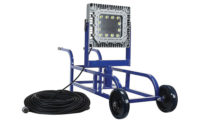LED technology
Unfortunately, too often the rising costs associated with workers' compensation insurance is overlooked. What is surprising is the fact that this expense is normally ranked within the top ten for corporate non-production-related expenditures.
Recent estimates have been made that indicate the total costs associated with occupational injuries and illness in the United States a few years ago was $247 billion. In 2000, the average cost associated with a work-related accidental death exceeded $25 million per incident, according to the National Safety Council. Fortunately, a well developed safety awareness program can significantly reduce these costs and have an immediate impact on the bottom line.
Raising awareness
It is widely accepted that the key to reducing incidents in the workplace is developing an effective safety awareness program. Such a program begins with a commitment from senior management, and involves many steps ranging from hazard recognition and defining safety objectives, to developing an effective awareness campaign. Many models, like six-sigma, are used to qualify the relative impact safety programs have on business operations. These models include steps that focus on measuring, analyzing, improving and controlling safety processes.Unfortunately, even the best designed programs often fail due to human error. It has been estimated that more than two-thirds of all occupational incidents within the U.S. are caused by human error. Most of these incidents could have been avoided if existing safety policies would have been properly followed. So how then can effective safety awareness programs compensate for these shortcomings?
In addition to static signs, horns and light beacons, real-time safety feedback devices can be incorporated into safety programs so that employees have access to live data. The data that today's devices display is much more than just "number of days since last accident." Advances in LED display technology have allowed for environmental condition reporting, flashing safety policy reminders and emergency condition instructions, as well as real-time safety goal versus actual data. Such instructions provide live feedback on proper fire evacuation routes based on fire locations detected by building monitoring systems.
LEDs to the rescue
Many effective safety awareness programs have implemented sophisticated software programs that track program metrics. These programs are often incorporated within a company's ERP systems, and are fed by data automatically from building monitoring systems, machine condition sensors and human data entry. Companies have literally spent millions of dollars implementing these systems only to find out that they have failed at effectively communicating the results to the people that can have the greatest impact on safety - the production workers. Safety managers have spent many hours developing detailed safety reports only to find them not being read. The problem may not reside in the quality of the information being presented, but in how and when the information is being presented.Advances in LED display technology have allowed safety managers to program real-time alphanumeric and, now, graphical data. What makes these display technologies so flexible is their ability to tie into many data systems. Several data formats are supported, and the higher level graphical displays even include actual PCs and Microsoft operating systems. This new open system display allows customers to use the millions of dollars of software and network architectures already installed.
Larger graphical displays using Microsoft operating systems can be used by multiple departments for displaying production data, employee data, along with safety data, all at the same time. This sharing helps amortize display costs and increases display effectiveness as a tool to be used on a regular basis. Many safety managers have concluded that based on human behavior models, employees will not use new visual annunciation equipment unless it can be used as an effective data feedback tool.
Commanding attention
What makes these systems so desirable? They command employee attention. Unlike static signs that can often be overlooked a few days after they are initially installed, LED displays can be programmed in different colors, based on severity of message. Tri-color displays provide different levels of safety annunciation importance. Green could be used to present safety reminders, yellow could be used for warnings, and flashing red is used for alarms. Emergency situations invoke graphical and alphanumeric instructions, based on the nature of the event.
Several safety managers place significant value on these higher end systems because they can provide accurate instruction to employees who may have either forgotten their class training, or have allowed the emergency situation to impair their judgement. In fact, the National Safety Council has estimated that ineffective employee communication alert systems are among the top ten causes of failed emergency response plans. This is particularly important in applications involving hazardous materials, where according to the National Environmental Law Center, six percent of chemical incidents that occur within the United States result in immediate injury, evacuations or death.

Measuring the return
Developing and implementing an effective safety awareness program can be justified in a number of ways. The goal is to ultimately save lives. Financially, effective safety awareness programs can reduce workers' compensation insurance premiums and lost production. More specifically, the costs associated with an incident, as identified by the National Safety Council, include:
- Wage and productivity losses;
- Medical expenses, like hospital and doctor charges and emergency services;
- Administrative expenses, like cost of public and private insurance, police and legal costs, claims paid out by insurance companies.
- Employer costs, like monetary value of time for uninjured workers, cost of injury investigation and reporting, production slowdowns, and so on.
- Disabling injury costs, resulting from death, or some degree of permanent impairment.
University of Arkansas researcher Terry Collins has developed an approach that actually measures the financial return on safety investments by using an analytical hierarchy process based on OSHA's Voluntary Protection Program (VPP). Essentially, this approach utilizes the benefit-to-cost ratio associated with a safety process system. Using this approach, the cost versus visual impact should be evaluated as illustrated in Figure 1.
Whether the costs associated with a safety awareness program are evaluated using the net present value of money or simple return on investment calculations, the results are similar in nature. Implementing well thought out safety awareness programs that take advantage of newer technology and already incurred software, hardware or network infrastructures provides concrete positive results to the bottom line.
Looking for a reprint of this article?
From high-res PDFs to custom plaques, order your copy today!




